Affiliate links on Android Authority may earn us a commission. Learn more.
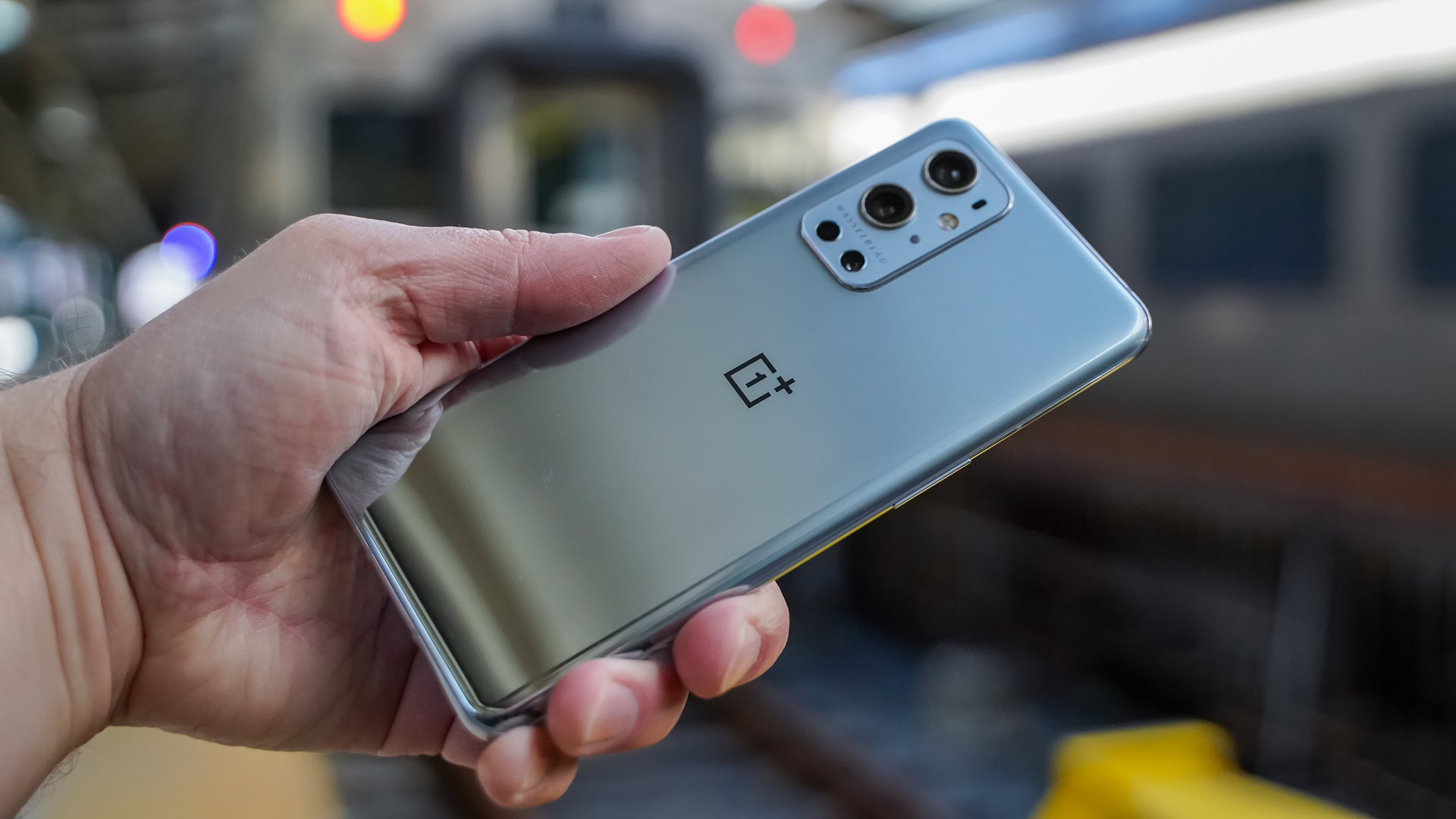


OnePlus 9 Pro
MSRP:
What we like
What we don't like
Our scores

OnePlus 9 Pro
After a prolonged hype campaign, OnePlus revealed its flagship phone for 2021: the OnePlus 9 Pro. It is OnePlus’ most expensive phone yet, but the company also believes it’s the first OnePlus device to truly stand as a full flagship — not as a flagship killer.
OnePlus doubled down on the technology in the OnePlus 9 Pro in order to make it a solid competitor with the industry’s elite. This includes OnePlus’ most ambitious camera system yet in a partnership with high-end camera maker Hasselblad. Is this new partnership the missing ingredient in OnePlus’s recipe for smartphone success? Find out in the Android Authority OnePlus 9 Pro review.
What you need to know about the OnePlus 9 Pro
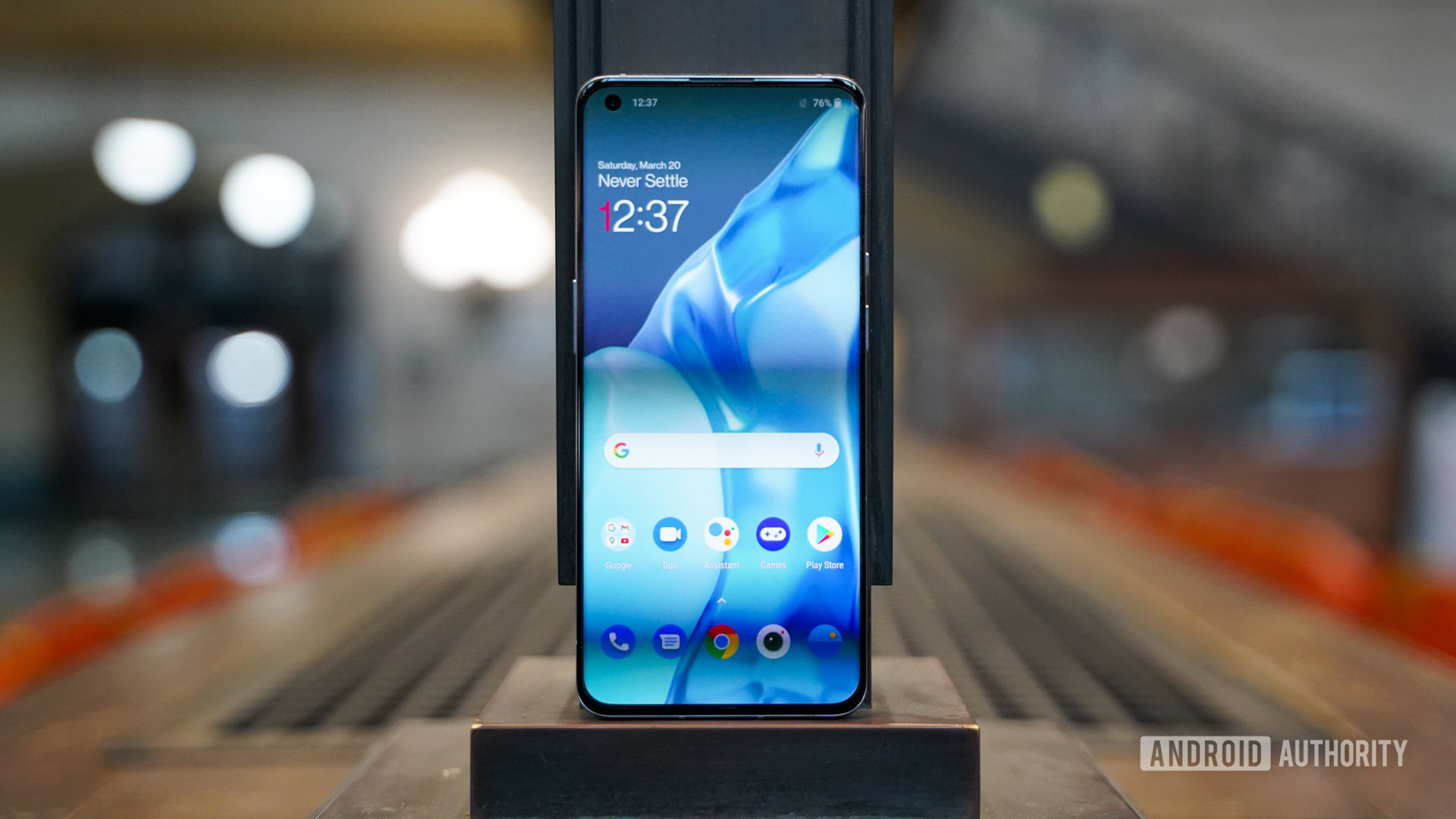
- OnePlus 9 Pro (12GB/256GB): $799 / £629 / €799 / Rs. 49,999
The OnePlus 9 Pro is a “full package premium device,” says OnePlus, thanks to the company’s investment in camera technology and its commitment to offering a phone that has the best display, software, and price on the market. I’ve had dozens of interviews with OnePlus over the years, and after listening to them this time, I can honestly say the company’s employees truly believe in the OnePlus 9 Pro’s flagship potential.
Now that the OnePlus 10 Pro is available (even if only in China), OnePlus has permanently dropped the price of the OnePlus 9 Pro. It originally hit the street with a cost of $1,069, but has since been reduced to $799 or the equivalent thereof in other markets. Dropping the price was the right move for the year-old phone as OnePlus gears up for the global launch of the OnePlus 10 Pro, though we don’t yet know the list price of the new flagship outside of China. In the meantime, the OnePlus 9 Pro remains a decent piece of hardware that’s perhaps more appealing to some with the new lowered price.
The phone continues to play in the same premium space as the Samsung Galaxy S22 and iPhone 13 families. OnePlus made no secret that it was targeting market-leading devices with the OnePlus 9 Pro. The company is no longer interested in playing in the “affordable flagship” space with its Pro devices — it wants to go head-to-head with the big boys. (The vanilla OnePlus 9 is available to for those who want a more traditional bang for your buck-style OnePlus phone.)
The OnePlus 9 Pro is going head-to-head with the big boys.
See also: Everything you need to know OnePlus
The OnePlus 9 Pro is sold in two memory configurations: 8GB RAM with 128GB storage, or 12GB RAM with 256GB storage. The 8GB model is not available in the US market. OnePlus offers the phone in three colorways, though availability depends on the market. In the US, the colors are Morning Mist and Pine Green; the Stellar Black model is offered alongside the others in global markets.
Those are the basics. Let’s dive into the specifics, shall we?
Design: Back to basics
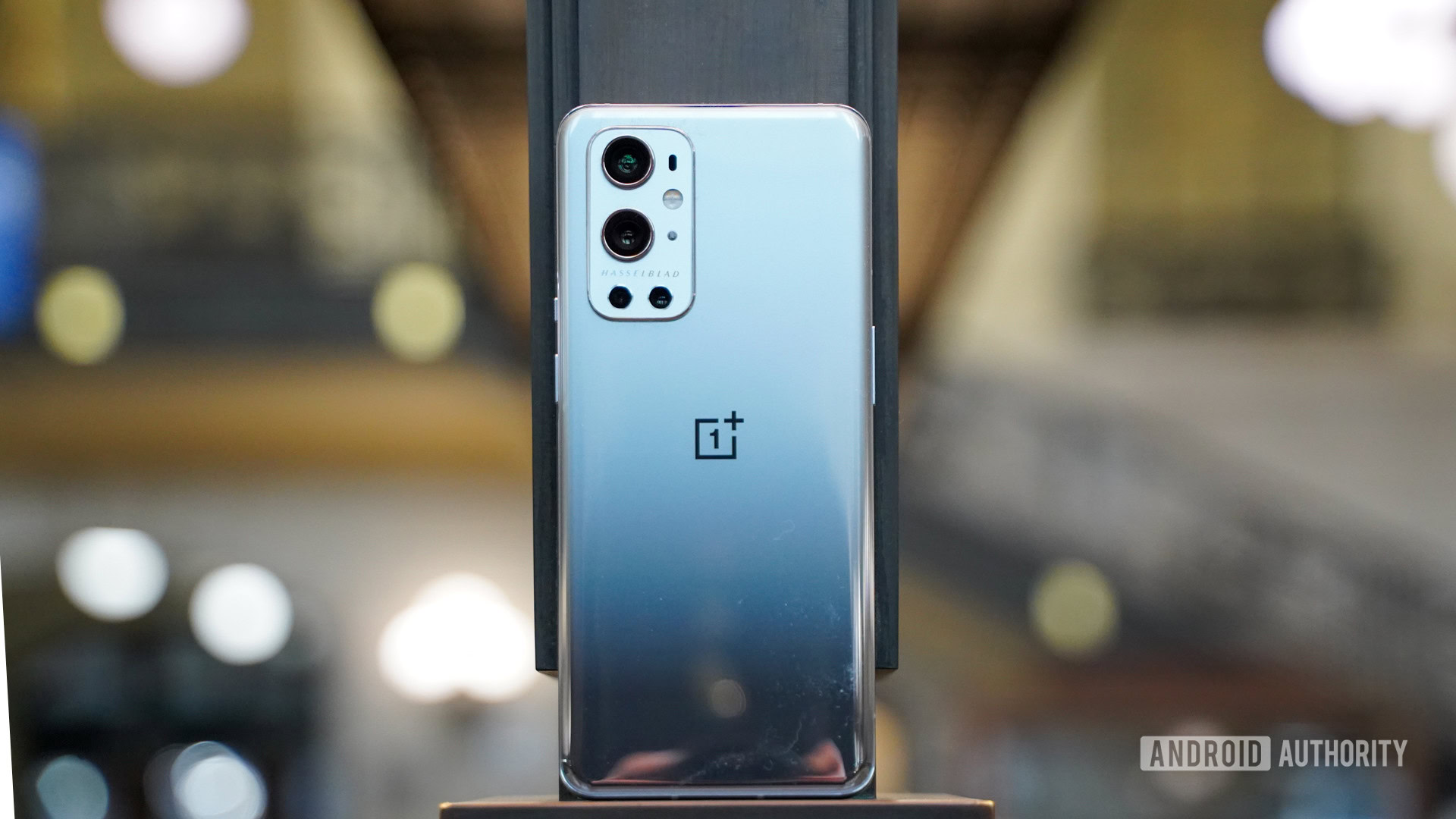
- Gorilla Glass 5 (front and back), aluminum (frame)
- 163.2 x 73.6 x 8.7mm
- 197g
- In-display fingerprint reader
- IP68
- USB-C
- Stereo speakers, Dolby Atmos
- Morning Mist, Pine Green, Stellar Black
I’ve generally been a fan of OnePlus’ minimalist design ethos, though I feel like the company lost its way in recent years. The OnePlus 3, 5, and 6 series were simple and cohesive, but the OnePlus 7 and OnePlus 8 families were a bit too much for my tastes. The 9 Pro sees OnePlus returning to its roots in the best way possible.
OnePlus phones history: The company’s entire lineup so far
“Burdenless design” is OnePlus’ marketing speak for the 9 Pro’s handsome looks. Two 3D curved glass panels, both Gorilla Glass 5, sandwich a thin aluminum frame. The curves are gentle and the glass mates perfectly with the metal along the seams. It makes for an incredibly comfortable hand feel. I’d have preferred to see the latest Gorilla Glass Victus standard here.
The frame itself is 2.2mm thick along the side rails and it widens to nearly the full 8.7mm thickness at the top and bottom ends. Silky smooth glass means the OnePlus 9 Pro is crazy slippery. I strongly suggest you use a case to protect the phone. OnePlus has its own selection of excellent first-party cases, but there are plenty of other options too.
The Morning Mist colorway I have is gorgeous. It transitions from near black at the bottom edge to near white at the top edge with a mirrored finish that rivals the stunning OPPO Find X3 Pro‘s good looks. I really like it. Thank goodness OnePlus kept the camera module design in check. The module is still sizable, but it doesn’t jut out from the rear glass as much as, say, the Samsung Galaxy S21 Ultra or Xiaomi Mi 11 Ultra camera modules do. Moreover, the lens arrangement is tasteful and simple in just the right ways.
The OnePlus 9 Pro's design sees the brand returning to its roots in the best way possible.
OnePlus carried over many of the phone’s other design elements from previous generations. For example, the alert slider is present and accounted for. This switch makes it easy to adjust from silent to vibrate to ringer on. The screen lock/power button is just below the switch on the right edge of the phone. You’ll find the volume toggle gracing the left edge. Both these buttons have excellent travel and feedback. A USB-C port is centered on the bottom edge and is flanked by the SIM card tray on the left and the downward-firing speaker on the right. There’s no expandable storage and no headphone jack.
As far as sound is concerned, the earpiece works together with the bottom-mounted speaker to produce a stereo effect. Sound coming from these two speakers is a bit imbalanced, with more volume punching out from the downward-firing speaker. This is common for this kind of speaker arrangement. Due to its placement, I found it was easy to muffle the sound by accidentally covering the bottom speaker when holding the phone horizontally, but it’s fine otherwise. The audio itself was a touch thin. I had trouble hearing bass lines in music, for example, and explosions didn’t come across as boomy as I’d have liked. Dolby Atmos is on board, though you’ll get a better overall experience through a good pair of headphones.
The in-display fingerprint reader is positioned far too low on the phone’s face; it’s right up against the bottom edge. This makes it sometimes awkward to reach. While I wish the reader were a little higher up on the display, it’s a breeze to train and use. It’s seriously quick and accurate when unlocking the phone. Standard camera-based face unlock is available as well, though I found the in-display fingerprint reader to be faster and more reliable.

Last, let’s cover a few quick extras. The haptics on the OnePlus 9 Pro are quite good. Whatever magic OnePlus worked with the haptic motor, the feel of the vibrations is much more fine-tuned than what’s available on previous OnePlus phones. The OnePlus 9 Pro also has an IP68 rating globally. That’s what we expect from a premium flagship.
The OnePlus 9 Pro is simple and seamless almost to a fault. A few small tweaks and it could have been perfect, but what’s here is OnePlus at its best.
Display: All that you need
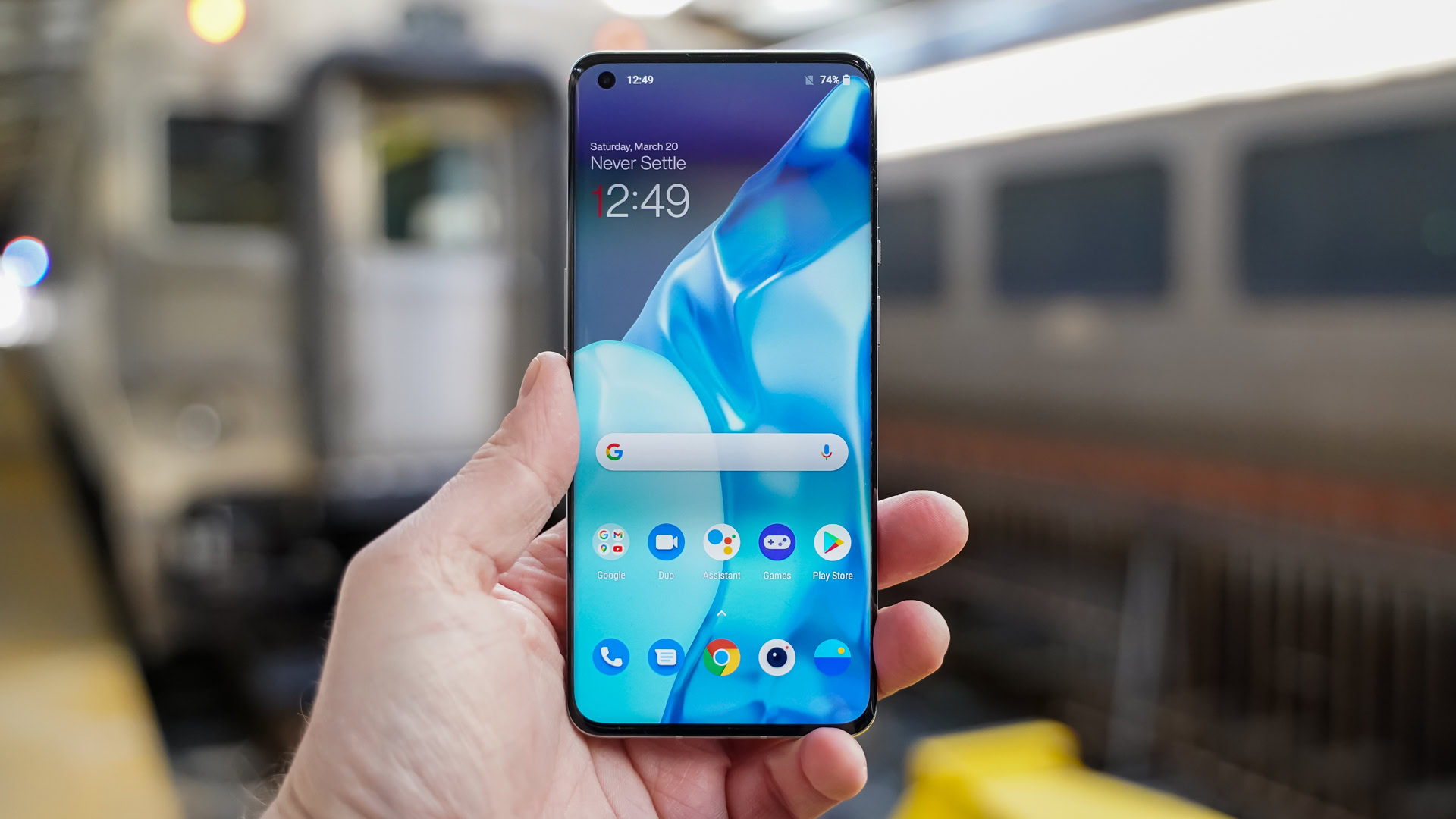
- 6.7-inch LTPO AMOLED with punch-hole
- 3,216 x 1,440 resolution
- 525ppi
- 20.1:9 aspect ratio, 120Hz refresh rate
OnePlus packed the 9 Pro’s “Fluid Display 2.0” with tech. To start, the 6.7-inch panel relies on LTPO AMOLED lighting. This allows for more efficient performance due to lower temperatures. The screen puts out 1,300 nits peak brightness, supports HDR10+, and features a micro-curve along the edges with enhanced protection against accidental touches. Let’s address this last point first. The curve is absolutely reduced when compared to the OnePlus 7 Pro and 8 Pro, which makes it much better for typing and rejecting accidental touches. It’s not a perfect implementation, but it’s an improvement for sure.
Then there’s the speed. The LTPO tech allows the display to range the refresh rate from 1Hz to 120Hz, depending on what content you’re looking at. This lets the screen scale power usage up and down as needed. OnePlus claims its variable refresh rate screen draws half as much power as a full-time 120Hz panel. You can also lock the refresh rate at the standard 60Hz if you want. The 60Hz setting is static, or non-variable. It’s mostly visible when scrolling up and down in apps such as Twitter or YouTube. The scroll stutters some rather than flowing smoothly like it does in the 120Hz setting.
In addition to the high refresh rate, the screen includes a 360Hz touch response rate, which OnePlus is calling Hyper Touch. It basically means the phone is that much better for gaming, and OnePlus scored four titles to support the top response rate at launch, including PUBG Mobile and Call of Duty: Mobile. OnePlus recently removed HyperTouch from the OnePlus 9 Pro with the Oxygen OS 12 update. It hasn’t said if the feature will return.
The OnePlus 9 Pro display delivers everything we've come to expect from modern Android flagships.
How does it all look? Fantastic. The device is set to 120Hz at Full HD+ resolution out of the box and it really impresses. It’s smooth when scrolling or panning around websites or other content. Your eyes won’t notice that the phone isn’t taking advantage of its full Quad HD+ resolution. It’s very clean and crisp. Brightness is excellent, colors are on point, and the display’s temperature is set accurately. With the resolution dialed up to the full QHD+ resolution and maximum frame rate, it simply stuns, albeit at a significant hit to battery life.
I tested some high-res Netflix content and several games and came away impressed. Compared to the already excellent displays found on the Samsung Galaxy S21 Ultra and Xiaomi Mi 11, the OnePlus 9 Pro can absolutely hold its own.
Last, you have lots of control over the behavior of the screen in the software. In addition to blue light filters, you can set color effects, motion graphics smoothing for gaming, reading mode, dark mode, as well as the ambient or always-on display settings.
The OnePlus 9 Pro display delivers everything we’ve come to expect from modern Android flagships and then some.
Performance: Geared for greatness
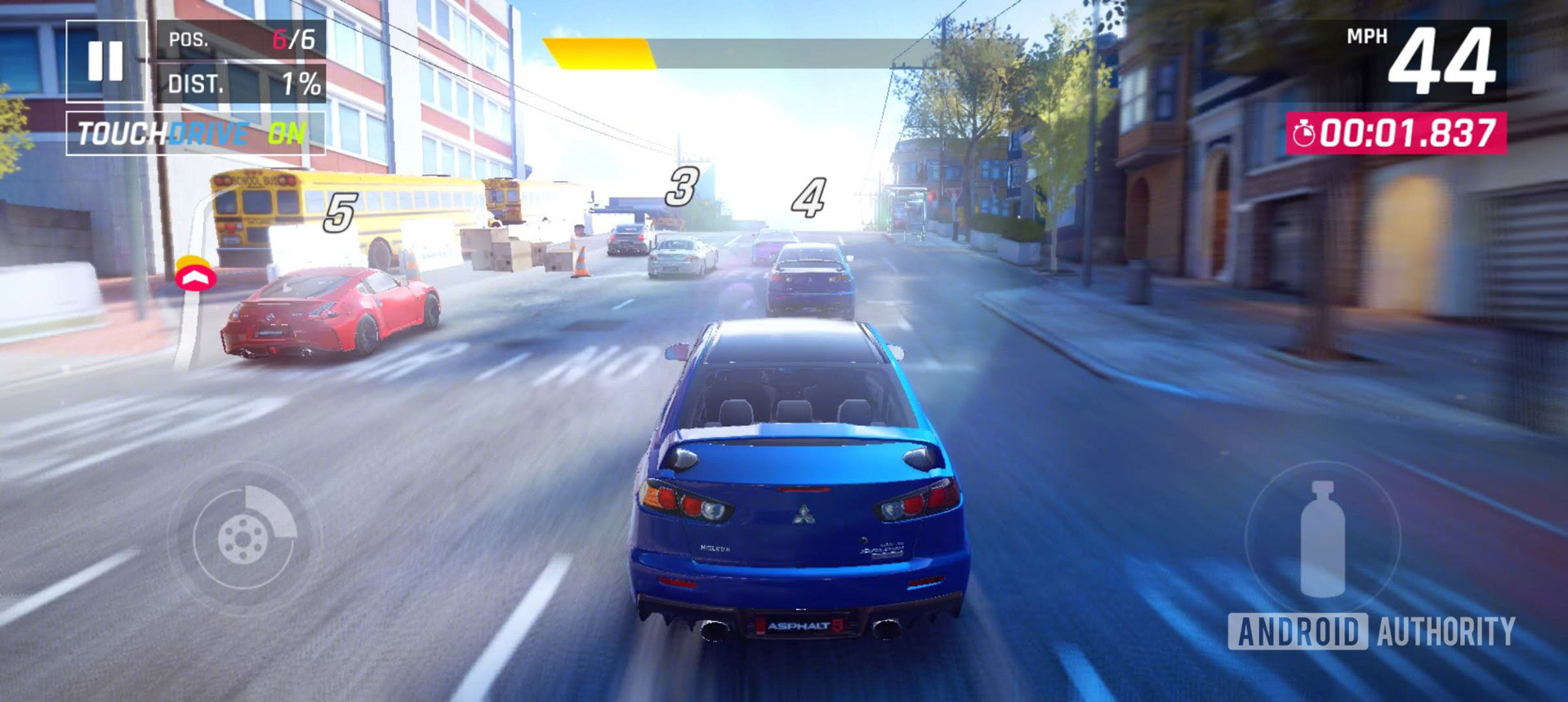
- Qualcomm Snapdragon 888
- Adreno 660
- 8GB/12GB LPDDR5 RAM
- 128GB/256GB storage
OnePlus made sure the 9 Pro has all the power you need no matter how you intend to use the phone. Whether you’re a social media maven, a YouTube fanatic, or a gaming guru, the OnePlus 9 Pro delivers the goods.
With a Snapdragon 888 processor on board, and either 8GB or 12GB of RAM, you’re set to handle everything and anything your daily use could throw at it. Even with the screen performance maxed out, the phone sailed through everyday tasks with ease. I didn’t encounter any stuttering or lagging. Multitasking didn’t drag on performance, nor did some heavy-duty streaming. The OnePlus 9 Pro performed like a champion day in and day out. The OnePlus 10 Pro packs the newer Qualcomm Snapdragon 8 Gen 1 flagship processor, which promises some speed, efficiency, and graphics improvements in the newer phone.
The 9 Pro handled benchmarks as expected. In most instances, the 9 Pro was on par with any other Snapdragon 888-powered flagship. Some phones with the Snapdragon 888 Plus outrun it, but not by much. We ran our custom Speed Test G benchmark and the 9 Pro scored well on the timed test at one minute 15 seconds. To put that in perspective, the Xiaomi Mi 11 nabbed 1:12 and the Samsung Galaxy S21 Ultra took 1:21. The OnePlus 9 Pro lands right where it should.
How does that translate to gaming? The phone has some gaming-centric tech built in to appease mobile players. Cool Play is OnePlus’ heat management system. The 9 Pro has an enlarged vapor chamber, thicker graphite sheets, and a larger copper foil to help keep the temperature down during gameplay. Then there’s Pro Gaming Mode, which blocks notifications from apps, calls, and other distractions so you can play uninterrupted. I tested Asphalt 9 and tried my hand at Fortnite (which I really suck at) and came away impressed with the performance. Frame rates were excellent, the action was smooth, and the responsiveness of the phone was top-notch. The OnePlus 9 Pro can hang with even the best gaming phones out there.
The OnePlus 9 Pro performs like a champion.
Then there’s the 5G story, which is a bit more mixed. The 9 Pro shipped with more 5G bands than nearly any other phone in the market at the time of launch. That may be true, but its support for 5G in North America is uneven. In the US, the OnePlus 9 Pro has the bands in place to deliver the fastest mmWave 5G speeds, but only if you’re on T-Mobile or Verizon. As far as AT&T is concerned, “AT&T users will only have 4G LTE service for unlocked versions” of the phone. That’s a major bummer.
Battery: Better be careful
- 4,500mAh
- Warp Charge 65T
- Warp Charge 50W Wireless
- Reverse wireless charging
OnePlus claims it nailed battery life with the 9 Pro, but I beg to differ. The company carried over the battery setup from the OnePlus 8T, which means there are two 2,250mAh cells inside the phone making for a total of 4,500mAh. That’s a good total battery size for this class of phone. No complaints there. Out of the box, the phone is set to the dynamic 120Hz mode at Full HD+ resolution. We mostly tested the 9 Pro in this default state but also checked the static 60Hz frame rate to be thorough.
With the stock configuration, the phone gets through a whole day, but barely. That’s with regular use: texting, social networking, browsing, maybe some photography. Gaming with the phone causes a serious strain on the battery. It sometimes felt like you could watch the phone drop 5% in just a few moments, and if you gamed for 30 minutes or more, there’s no way the phone would make it past dinner. That’s not great. Moreover, if you turn on the always-on display, prepare yourself for another dip in battery life.
OnePlus tries to solve the 9 Pro's battery shortcomings with raw charging speed.
If you dialed the frame rate back to the static 60Hz setting, then the phone suddenly lasted a good day and a half. That’s good news if you’re concerned about battery life. In other words, the phone can make it well past a day, but you have to adjust it to make that a reality. Still, I wish battery life with the out-of-the-box setting were better. Newer phones with 120Hz displays seem to have solved this issue. For example, the Google Pixel 6 Pro blasted through an entire day with no problem despite setting the screen at 120Hz all day.
OnePlus attempts to make up for the battery’s shortcomings with raw charging speed. To start, the phone supports Warp Charge 65T and ships with a 65T charger in the box. (Not all flagships included chargers these days.) OnePlus said the phone could charge from 0% to 75% in 20 minutes and 0% to 100% in 29 minutes. I found those numbers to be completely accurate. Connecting the phone to the charger for mere minutes translated to a huge boost in battery charge. It’s no 160W charger, but it gets the job done.
Related: The best wall chargers
This impressive charging performance also applies to wireless charging. The phone supports Warp Charge 50 Wireless, which is 50W charging when on the OnePlus-made wireless charger. Using the optional charging stand ($69) sees the phone power up from 0% to 70% in 30 minutes and from dead to full in 50 minutes. Again, our numbers match OnePlus’ claims. That’s ridiculous. That’s only if you’ve got the OnePlus wireless charger, though, as regular chargers will default to a maximum of 15W.
Whether you use OnePlus’ proprietary wired or wireless connection, if your OnePlus 9 Pro is nearly dead when you get home from work, charging it for just a little bit while you make dinner or get ready to go out will be enough to get you through the rest of the evening. That said, I do wish the phone managed to get to bedtime consistently without a midday power up.
Last, there’s reverse wireless charging on board, which caps at 5W. That’s slow, but on par with other devices that offer the feature and enough to charge up a pair of true wireless earbuds if you have the power to spare.
Camera: A definite improvement
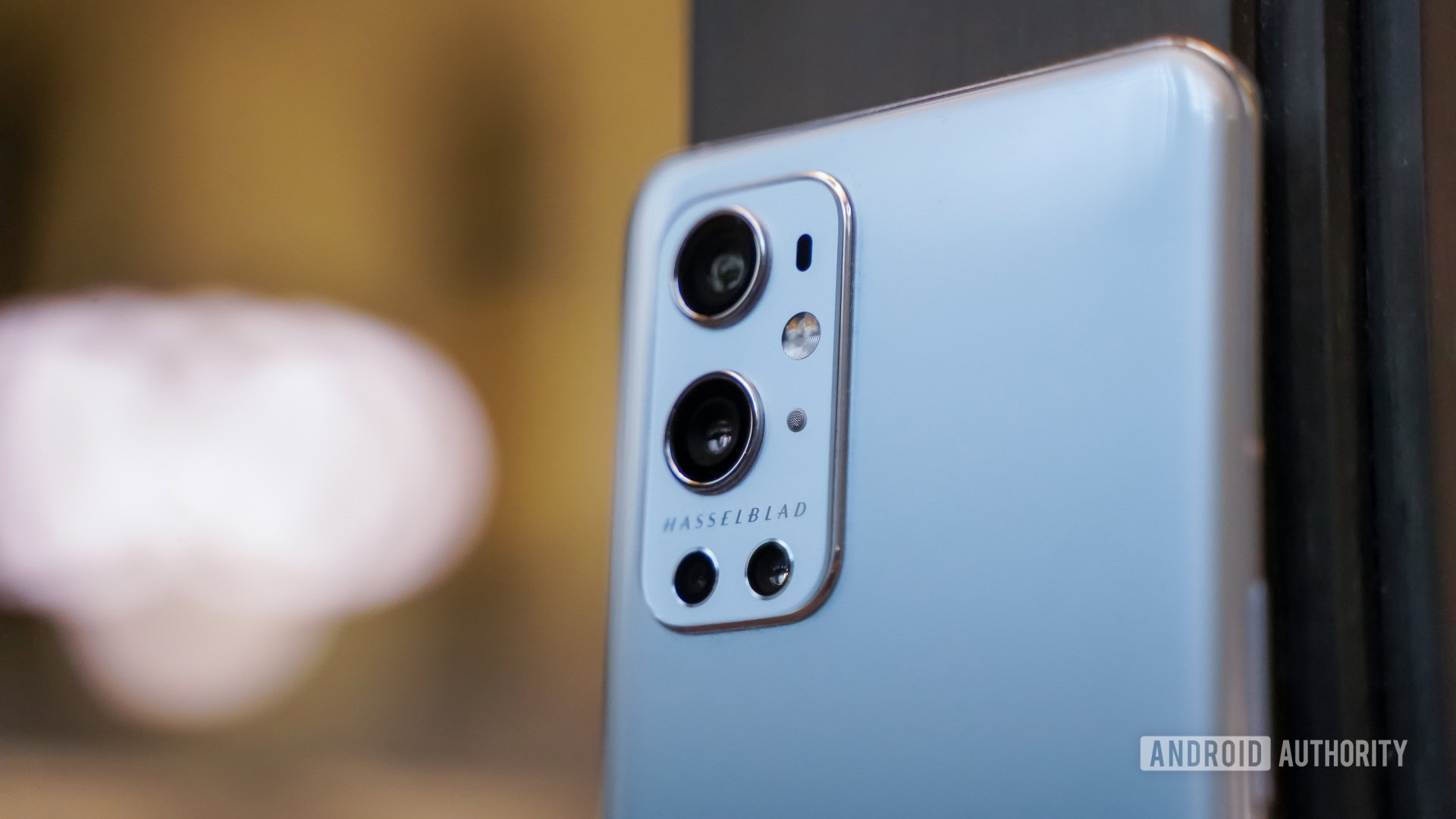
- 48MP OIS EIS ( f/1.8, 1.12μm)
- 50MP ultra-wide ( f/2.2)
- 8MP telephoto (f/2.4, 1.0μm)
- 2MP monochrome sensor
- Front: 16MP (f/2.4)
- Video: 8K at 30fps, 4K at 120fps
The OnePlus 9 Pro’s camera is all about the Hasselblad partnership. There’s no question OnePlus is using both the Hasselblad name and the software to up its own photography game. Does that make the 9 Pro a winner?
See also: The best camera phones you can get
According to OnePlus, the Hasselblad collaboration is a multi-year project that goes a lot deeper than just slapping a logo onto the back of the phone. During this first year of the agreement, the two companies worked together on a software level. The agreement planned to reach the hardware level over time, said OnePlus. For now, the OnePlus 9 Pro makes use of Hasselblad’s natural color calibration to create true-to-life colors when shooting via the main lens. Calibration is applied at the sensor level with Hasselblad’s image processing software. The camera app also mimics Hasselblad’s trademark camera “click” sound, if you’re into that sort of thing.

The main sensor is a custom-built Sony IMX789. It captures images that are clean thanks to the on-chip lens, 12-bit RAW capability, and DOL-HDR. Photos are binned down by a factor of four to 12MP, but you can opt for the full 48MP resolution if you wish. I was very pleased with the photos that came from the main lens. Colors look rich, warm, and accurate, focus was sharp and crisp, and exposure was generally spot-on. I saw trace amounts of over-sharpening in low-light shots, but nothing to be overly concerned with. HDR performance could also have been a bit better.
OnePlus went extra wide with the ultrawide lens, which relies on a Sony IMX766 sensor, mirroring the OPPO Find X3 Pro. This 50MP camera puts a freeform lens to use with what OnePlus called a “series of unique curves” to straighten out incoming light. The result? Ultrawide shots that are 99% free of edge distortion. OnePlus wasn’t lying. The ultrawide shots I took were generally free of the distorted look that’s common to wide-angle photos. I kind of like the distortion of ultrawide cameras sometimes, but there’s no denying how impressive the results were here. More importantly, the color did a good job matching that of the main sensor, even if it’s not 100% perfect.
Thank goodness OnePlus got with the program and decided to offer a competitive telephoto lens in the 9 Pro’s camera system. It’s no periscope-aided beast, but at least it handles basic 3.3x optical zoom and up to 30x digital zoom. I wish it captured more than 8MP, but the 3.3x optical zoom performance is quite good. The 30x zoom, meanwhile, is near worthless, but that’s hardly a surprise. The OnePlus 9 Pro also has a 2MP monochrome camera to enhance black and white photos shot from the main shooter.
As for portrait mode, you can see from the two samples below that there’s solid separation between the subject and the background. I especially like the softer effect in the second photo.
The 16MP selfie camera does a fair job. In the standard selfie below I am in sharp focus and there’s plenty of detail still visible in the background. However, the portrait selfie creates far too much blur in the background and it can’t be adjusted from the portrait mode. You can hardly tell that there’s a city behind me. At least edge detection is good and I’m not missing and more hair than I already am.
On the video front, the 9 Pro can capture video up to 8K at 30fps and 4K at up to 120fps, with various other frame rates and resolutions available for slow-motion, hyper-lapse, and standard video. The video I shot looked really good on my 4K monitor. Everything about the footage was clean, accurate in terms of color, with sharp focus and proper white balance. I was very pleased overall.
The OnePlus 9 Pro camera outperforms all of its predecessors.
OnePlus has done a fine job in closing the gap with its competitors. Its cameras have traditionally fallen well short of its marketing claims. The 9 Pro outperforms all its predecessors but is still not without faults. The biggest detractors are iffy HDR performance and some over-sharpening. These don’t ruin the experience, but competing phones do better. Now that we’re into 2022, the list of cameras that outperform the OnePlus 9 Pro has grown, including the Google Pixel 6 Pro, Apple iPhone 13 Pro, and Samsung Galaxy S22 family. We’ve yet to test the camera of the OnePlus 10 Pro, but will do so as soon as the global version launches.
Comparison: Camera shootout — OnePlus 9 Pro vs Samsung Galaxy S21 Ultra
As for the color, I don’t think it’s going to be for everyone. The color is accurate — scarily so — when compared to the real-world settings in which the photos were shot. Some people prefer to see oversaturated photos (think Samsung). You won’t get that here. If you prefer to see a boost in color vibrance, you might want to look elsewhere. The remedy to this for pros is the 12-bit RAW mode which allows for more tweaks in post.
The camera app is mostly carried over from the existing Oxygen OS 11 app that’s already available to other OnePlus phones. Astute observers will note that the shutter button is Hasselblad orange, rather than the typical white. The other big addition is the Pro Mode, which was designed with Hasselblad and offers knowledgeable users direct access to tools such as the shutter speed, aperture, brightness, and so on. This is how you capture the 12-bit RAW photos if you want them.
Mid-2021 mega shootout: The best camera phones so far tested
OnePlus and Hasselblad updated the OnePlus 9 Pro’s camera software later to include the Hasselblad XPan feature.
Software: This Oxygen is clean
- Android 11 (at launch)
- OxygenOS 11.2 (at launch)
OnePlus’ user interface skin, OxygenOS, is usually a fan favorite. The company’s philosophy is to create smooth, fast experiences with its software. Though not everyone is enamored with the Android 11-based OxygenOS 11, I found it was a fine platform for the device at launch. Some users didn’t like the change in core system fonts from Roboto to OnePlus Sans, for example, as well as the UI’s revamped use of white space. For a longtime OnePlus user, I suppose these changes could be jarring. If you’re coming from a OnePlus 8, chances are you’re already using Android 11 anyway.
Things I dig include the always-on display, the clean look, the simple touches, and the raw speed. You can customize nearly everything about the user interface in a way that suits you. There’s practically no bloatware at all save for Netflix, which you cannot delete, only disable.
Not everyone loves OxygenOS 11, but I dig it.
If there’s one thing worth bringing up, it’s the new Turbo Boost 3.0 memory optimization tool. This refreshed task manager is able to keep 25% more apps open and running in the background without needing to put them to sleep. OnePlus did this by compressing the data in the RAM and using some of the unused storage like RAM. The result cannot be denied. The phone manages background tasks more efficiently and it is less aggressive at killing apps you might want to keep running.
As for long-term support, OnePlus typically offers two years of Android upgrades and three years of security patches, but the company has recently updated its policies. Moving forward, the OnePlus 8 series and newer devices (including the OnePlus 9 Pro) will receive three major Android updates and four years of security updates. That matches Google, buy is short of Samsung’s new commitment.
Since launch, OnePlus updated the OnePlus 9 Pro to Android 12 and Oxygen OS 12 in waves starting in late December 2021 and early January 2022. The company had initially announced plans to merge its OnePlus Oxygen OS with its OPPO Color OS into a unified platform. This would have eventually impacted the OnePlus 9 Pro. However, OnePlus recently backtracked on these plans and will instead continue to develop Oxygen OS separately for its OnePlus phones that are sold outside of China.
Check out: Oxygen OS 12 hands-on — what you need to know
OnePlus 9 Pro specs
| OnePlus 9 | OnePlus 9 Pro | |
|---|---|---|
Display | OnePlus 9 6.55-inch flat AMOLED 20:9 aspect ratio 2,400 x 1,080 at 402ppi 120Hz refresh rate (static) | OnePlus 9 Pro 6.7-inch curved LTPO AMOLED 20.1:9 aspect ratio 3,216 x 1,440 at 525ppi 120Hz refresh rate (adaptive) |
Processor | OnePlus 9 Qualcomm Snapdragon 888 | OnePlus 9 Pro Qualcomm Snapdragon 888 |
RAM | OnePlus 9 Min: 8GB LPDDR5 Max: 12GB LPDDR5 | OnePlus 9 Pro Min: 8GB LPDDR5 Max: 12GB LPDDR5 |
Storage | OnePlus 9 Min: 128GB UFS 3.1 Max: 256GB UFS 3.1 No external storage support | OnePlus 9 Pro Min: 128GB UFS 3.1 Max: 256GB UFS 3.1 No external storage support |
Power | OnePlus 9 4,500mAh battery Warp Charge 65T 65W charger in box 15W Qi-compatible wireless charging (Wireless only in NA/Europe) | OnePlus 9 Pro 4,500mAh battery Warp Charge 65T 65W charger in box Warp Charge 50 Wireless 10V/6.5A, 20V/3.25A Output: 50W (with prop. charging stand) |
Ports | OnePlus 9 USB-C 3.1 Gen 1 No 3.5mm headphone jack No microSD card slot | OnePlus 9 Pro USB-C 3.1 Gen 1 No 3.5mm headphone jack No microSD card slot |
Connectivity | OnePlus 9 5G support Wi-Fi 6 support 2x2 MIMO Wi-Fi 802.11 a/b/g/n/ac/ax NFC support Bluetooth 5.2 | OnePlus 9 Pro 5G support Wi-Fi 6 support 2x2 MIMO Wi-Fi 802.11 a/b/g/n/ac/ax NFC support Bluetooth 5.2 |
Cameras | OnePlus 9 Rear: 1) 48MP main (Sony IMX689) 1/1.43-inch sensor 1.12μm/46MP or 2.24μm/12MP ƒ/1.8, EIS 2) 50MP ultra-wide (Sony IMX766) 1/1.56-inch sensor ƒ/2.2 3) 2MP monochrome Front: - 16MP single (Sony IMX471) 1.0μm with EIS ƒ/2.4, fixed focus | OnePlus 9 Pro Rear: 1) 48MP main (Sony IMX789) 1/1.43-inch sensor 1.12μm/46MP or 2.24μm/12MP ƒ/1.8, EIS, OIS 2) 50MP ultra-wide (Sony IMX766) 1/1.56-inch sensor ƒ/2.2 3) 8MP telephoto 1.0μm, ƒ/2.4 4) 2MP monochrome Front: - 16MP single (Sony IMX471) 1.0μm with EIS ƒ/2.4, fixed focus |
Video | OnePlus 9 8K at 30fps 4K at 30 or 60fps Super slo-mo at 720p/480fps or 1080p/240fps Time lapse at 1080p/30fps or 4k/30fps | OnePlus 9 Pro 8K at 30fps 4K at 30, 60, or 120fps Super slo-mo at 720p/480fps or 1080p/240fps Time lapse at 1080p/30fps or 4k/30fps |
Audio | OnePlus 9 Bluetooth 5.2 aptX, aptX HD, LDAC, AAC Dual stereo speakers Dolby Atmos | OnePlus 9 Pro Bluetooth 5.2 aptX, aptX HD, LDAC, AAC Dual stereo speakers Dolby Atmos |
Security | OnePlus 9 No IP rating against water/dust In-display fingerprint sensor Face unlock (insecure) | OnePlus 9 Pro IP68-rated In-display fingerprint sensor Face unlock (insecure) |
Software | OnePlus 9 Android 11 Oxygen OS 11 | OnePlus 9 Pro Android 11 Oxygen OS 11 |
Dimensions and weight | OnePlus 9 NA/Europe: 160 x 74.2 x 8.7mm 192g India/China: 160 x 73.9 x 8.1mm 183g | OnePlus 9 Pro Global: 163.2 x 73.6 x 8.7mm 197g |
Colors | OnePlus 9 Winter Mist, Arctic Sky, Astral Black | OnePlus 9 Pro Morning Mist, Pine Green, Stellar Black |
Value and competition
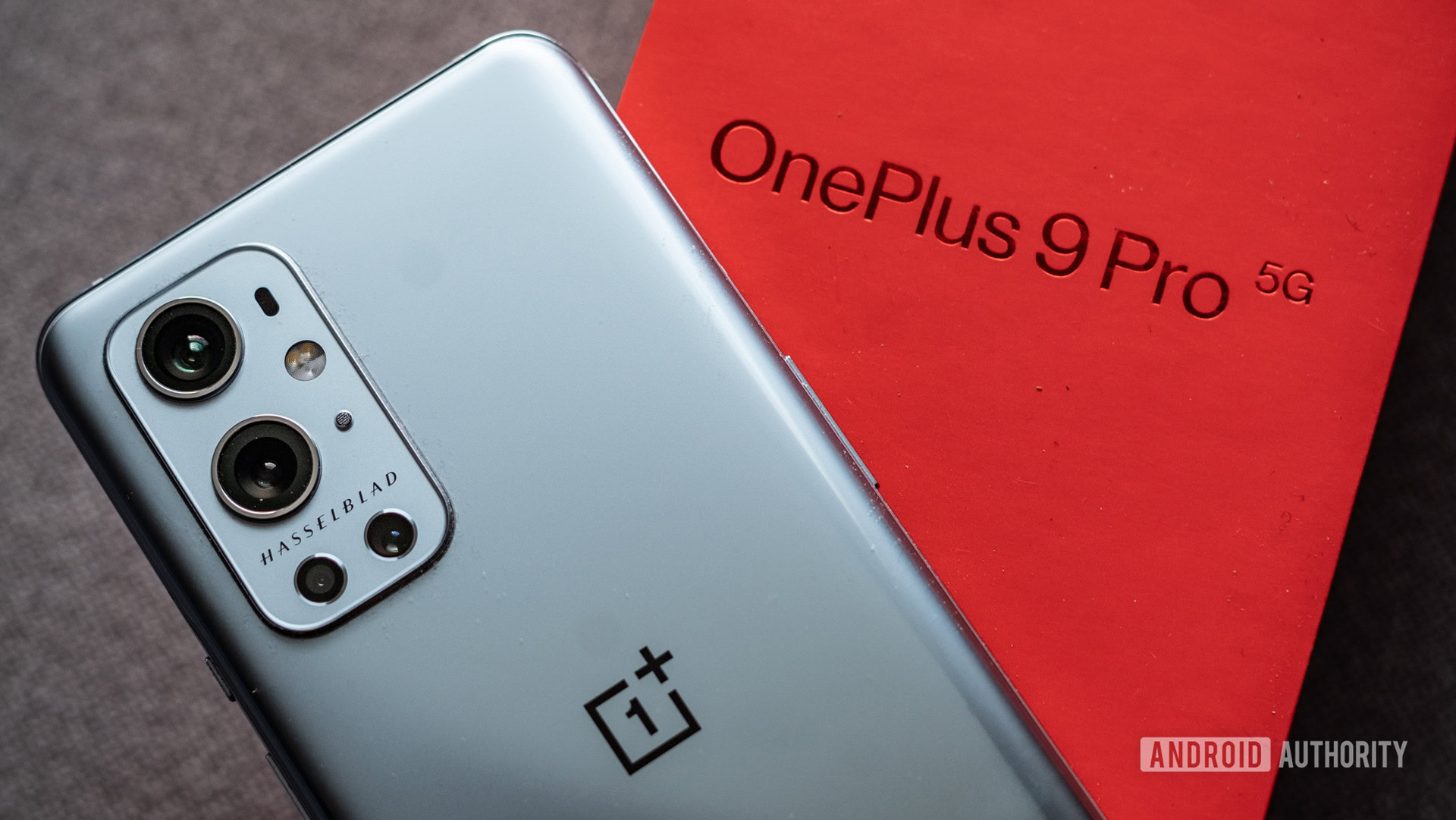
The initial value of the OnePlus 9 Pro has changed dramatically since it was first released. With the OnePlus 10 Pro in the market, the company has dropped the 9 Pro’s price to a more palatable $799. That makes it a bargain for those who don’t mind picking up last year’s phone.
The OnePlus 9 Pro originally played in the same price range as the Samsung Galaxy S21 Plus ($999) and iPhone 13 Pro ($999). The new, reduced price puts it in closer competition with the Samsung Galaxy S22 ($799) and iPhone 13 ($799).
The phone’s new $799 price makes it a bargain for those who don’t mind picking up last year’s phone.
Photography, as is often the case, is the main differentiator between the very best. In this group, the iPhone 13 Pro Max and Galaxy S22 Ultra are still the standouts. That said, the performance of the OnePlus 9 Pro was easily comparable with other early 2021 flagships. Each has pros and cons when it comes to photography, so personal preference was a big factor. You can get a better feel for how the cameras compare directly in our shootout.
If you’re looking for something smaller and cheaper, you have the ASUS Zenfone 8 ($630) to consider. This tiny titan offers everything a flagship does in a smaller, more compact package.
At this point in the game, however, Google’s Goliaths have finally showed up. The Pixel 6 Pro ($899) and Pixel 6 ($599) are now on sale and they are excellent devices. They beat the OnePlus 9 Pro in battery life, camera results, and software/support from Google.
Related: The best Android phones
OnePlus did a commendable job with the OnePlus 9 Pro. It’s not quite up to par with the very best of the best, but it’s closer than OnePlus has ever been in the past. It’s no longer a flagship killer, even if it’s not quite the ultimate killer flagship.
OnePlus 9 Pro review: The verdict
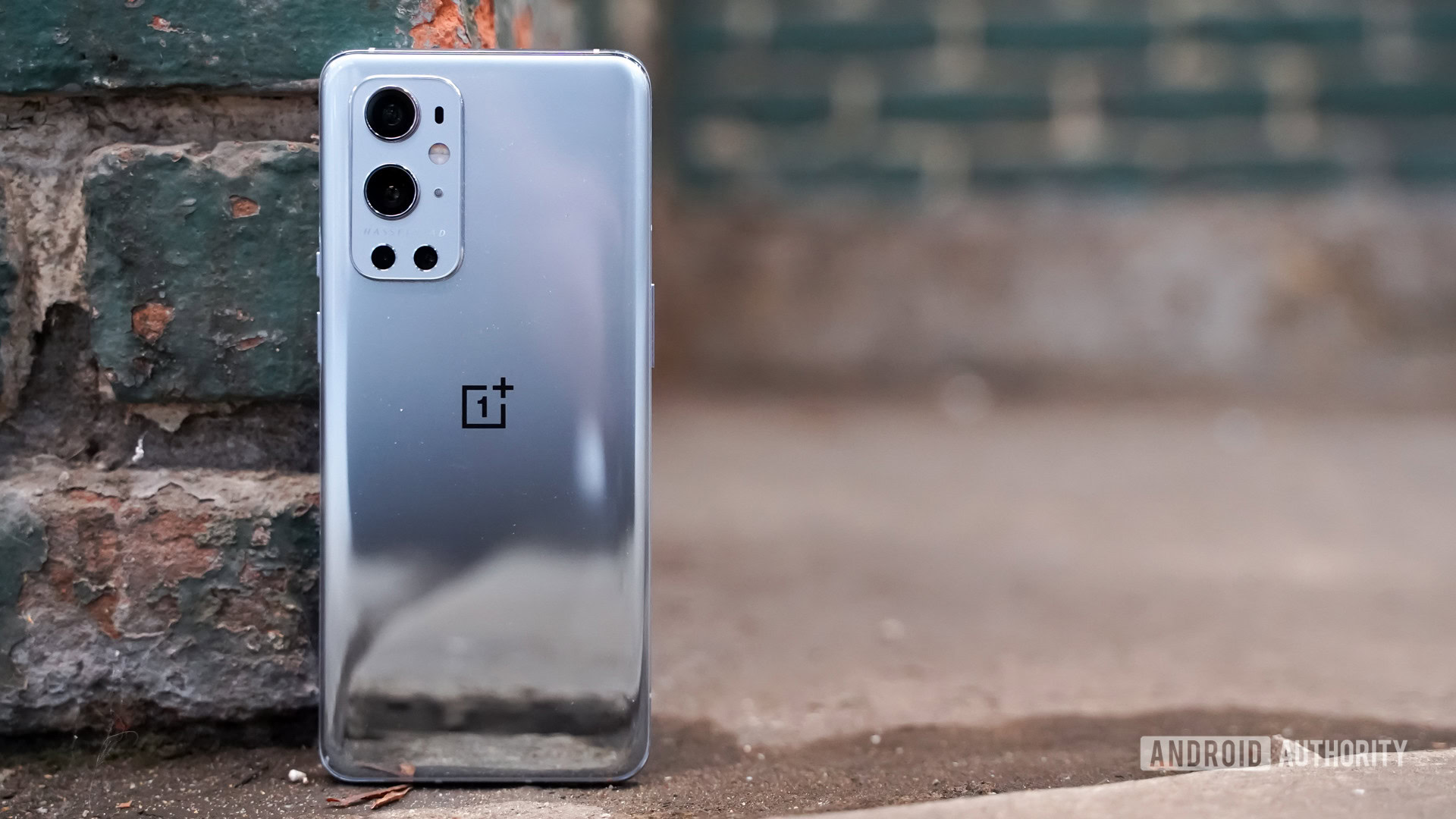
OnePlus has never come so close to getting it all right. It blended a series of specs and features into a cohesive whole that really resonates. OnePlus massaged details small and large in order to make the 9 Pro a phone that nearly toppled the industry leaders. Nearly.
In its favor, the OnePlus 9 Pro enjoys an attractive design, an excellent display, smooth performance, and superb software. Toss in some of the fastest charging on the market and you have a winner. Most crucially, OnePlus made great strides with the camera, which was finally a competitive offering. It’s not the very best, but it significantly closed the gap between OnePlus and its competitors.
OnePlus has crafted a classic. The OnePlus 9 Pro is its best smartphone in years.
Battery life is among several things that hold the phone back. Some might also be unhappy about the missing microSD card, but 256GB should be enough storage for most people. Then there’s 5G. While plenty of 5G bands are on board, its lack of support for AT&T 5G in the US is a significant blow for potential buyers not on Verizon and T-Mobile.
Even with these flaws, there’s no doubt that OnePlus crafted a classic. The OnePlus 9 Pro is its best effort in years and one wholly worth considering.
Revisited: OnePlus 9 Pro — the good and the bad six months later